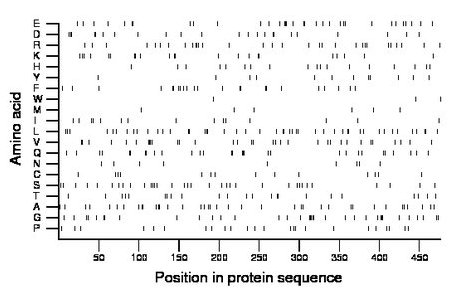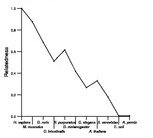
| Name: NARFL | Sequence: fasta or formatted (476aa) | NCBI GI: 11968051 | |
|
Description: nuclear prelamin A recognition factor-like
|
Referenced in:
| ||
|
Composition:

Amino acid Percentage Count Longest homopolymer A alanine 8.2 39 2 C cysteine 2.9 14 1 D aspartate 4.8 23 2 E glutamate 6.9 33 3 F phenylalanine 4.8 23 2 G glycine 7.4 35 3 H histidine 3.8 18 1 I isoleucine 3.2 15 1 K lysine 4.6 22 2 L leucine 9.9 47 2 M methionine 1.5 7 1 N asparagine 1.9 9 1 P proline 5.0 24 1 Q glutamine 6.3 30 3 R arginine 6.7 32 2 S serine 7.1 34 1 T threonine 4.8 23 2 V valine 6.9 33 3 W tryptophan 0.6 3 1 Y tyrosine 2.5 12 1 |
Comparative genomics:
Search single species RefSeq proteins at NCBI
Search summary 
Figure data | ||
Related human proteins:Protein Relative score Description Self-match 1.000 nuclear prelamin A recognition factor-like NARF 0.434 nuclear prelamin A recognition factor isoform a [Homo... NARF 0.410 nuclear prelamin A recognition factor isoform b [Hom... NARF 0.406 nuclear prelamin A recognition factor isoform c [Hom... NARF 0.390 nuclear prelamin A recognition factor isoform d [Ho... CYTSA 0.006 cytospin A CYTSA 0.006 cytospin A CACNA1B 0.006 calcium channel, voltage-dependent, N type, alpha 1B ... POU6F1 0.005 POU class 6 homeobox 1 NR1H4 0.004 nuclear receptor subfamily 1, group H, member 4 [Homo... TAOK1 0.004 TAO kinase 1 STARD8 0.004 StAR-related lipid transfer (START) domain containi... STARD8 0.004 StAR-related lipid transfer (START) domain containi... STARD8 0.004 StAR-related lipid transfer (START) domain containin... GIPC2 0.004 PDZ domain protein GIPC2Human BLASTP results (used to prepare the table) | |||
Gene descriptions are from NCBI RefSeq. Search results were obtained with NCBI BLAST and RefSeq entries. When identical proteins are present, the self-match may not be listed first in BLASTP output. In such cases, the table above has been reordered to place it first.
See About the Figures for the scoring system used in the figure above right. The same scoring system was used in the table of BLASTP results.
Guide to the Human Genome
Copyright © 2010 by Stewart Scherer. All rights reserved.
